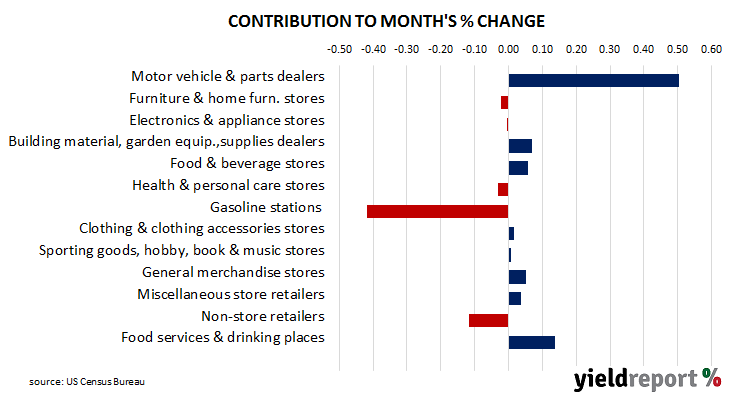Summary: US retail sales up 0.3% in August, more than expected; July figure revised down; spending “not falling in any significant way”; US short-term Treasury bond yields up, rate rise expectations harden; rises in eight of thirteen retail categories; “motor vehicles/parts dealers” segment largest single influence on month’s result.
US retail sales had been trending up since late 2015 but, commencing in late 2018, a series of weak or negative monthly results led to a drop-off in the annual growth rate below 2.0%. Growth rates then increased in trend terms through 2019 and into early 2020 until pandemic restrictions sent it into negative territory. A “v-shaped” recovery then took place which was followed by some short-term spikes as federal stimulus payments hit US households in the first and second quarters of 2021.
According to the latest “advance” numbers released by the US Census Bureau, total retail sales increased by 0.3% in August. The rise was above the flat result which had been generally expected and it contrasted with July’s -0.4% after it was revised down from 0.0%. However, on an annual basis, the growth rate still slowed from July’s revised figure of 10.1% to 9.1%.
“Overall, the data don’t send a clear message but make it clear that consumer spending is not falling in any significant way,” said ANZ Head of Australian Economics.
Short-term US Treasury bond yields moved higher on the day while longer-term yields remained steady or fell. By the close of business, the 2-year Treasury yield had gained 5bps to 3.82%, the 10-year yield had returned to its starting point at 3.44% while the 30-year yield finished 2bps lower at 3.50%.
In terms of US Fed policy, expectations of a steeper path for the federal funds rate over the next 12 months hardened. At the close of business, October contracts implied an effective federal funds rate of 3.14%, 81bps higher than the current spot rate. November contracts implied 3.775% while October 2023 futures contracts implied an effective federal funds rate of 4.20%, nearly 190bps above the spot rate.
Eight of the thirteen categories recorded higher sales over the month. The “Motor vehicle & parts dealers” segment provided the largest single influence on the overall result, rising by 2.8% for the month. Fuel Station sales also had a significant influence on the month’s result but in the opposite direction, falling by 4.2%.
The non-store segment includes vending machine sales, door-to-door sales and mail-order sales but nowadays this segment has become dominated by online sales. It now accounts for just under 16% of all US retail sales and it is the second-largest segment after vehicles and parts.



